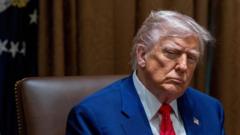In the wake of a turbulent week in trade policy, President Donald Trump appears to be at a crossroads regarding his ambitious trade goals. Last week, he introduced a significant tariff plan aimed at reshaping global trade dynamics and altering long-standing alliances. However, he has since put a hold on higher tariffs against most nations for 90 days to intensify a trade conflict specifically with China. This strategic retreat raises questions about Trump's actual progress toward fulfilling his trade agenda.
One of Trump's primary objectives is to secure better trade agreements. He has repeatedly criticized foreign nations for exploiting America’s economy. His initial proposal, which called for a blanket 10% tariff and additional penalties on 60 "offending" countries, sent shockwaves through international markets. Although Treasury Secretary Scott Bessent stated over 75 global leaders have reached out to Trump for negotiation, concrete agreements are still pending with key partners like South Korea and Japan. With the impending expiration of the 90-day negotiation window, the urgency for action is palpable.
On the domestic front, Trump has long championed the idea that tariffs could revitalize U.S. manufacturing by minimizing foreign competition. However, the unpredictability surrounding his tariff strategies leaves businesses hesitant to commit to new manufacturing investments. Many may choose to defer decisions until a clearer, more stable trade environment emerges.
Trump's confrontational stance towards China is another critical aspect of his trade vision. While he has acknowledged that previous administrations share some blame for the trade imbalance, his current rhetoric points to China as the primary adversary. This confrontation, however, could carry significant risks, especially when it potentially alienates crucial allies needed to counteract China’s influence.
Moreover, Trump has framed tariffs as a means to increase government revenue, which he aims to utilize to alleviate the national debt and fund tax cuts. Experts have projected substantial revenue generation from tariffs. Nevertheless, this has prompted concerns about how long these revenues can continue, especially as American companies might shift towards domestic production, reducing reliance on imported goods.
Lastly, Trump claims that increased domestic production through tariffs will eventually lead to lower consumer prices. Yet many economic analysts warn this might backfire, with tariffs likely escalating consumer costs in the short term. The Tax Foundation previously estimated that a 10% tariff could raise household costs significantly, disproportionately affecting lower-income Americans.
As Trump navigates this complex trade landscape, the impacts of his decisions will resonate throughout the U.S. economy and shape his political fortunes moving forward. The forthcoming weeks will be pivotal in determining whether he can translate his ambitious trade proposals into tangible outcomes or if he risks further entrenching the status quo.
One of Trump's primary objectives is to secure better trade agreements. He has repeatedly criticized foreign nations for exploiting America’s economy. His initial proposal, which called for a blanket 10% tariff and additional penalties on 60 "offending" countries, sent shockwaves through international markets. Although Treasury Secretary Scott Bessent stated over 75 global leaders have reached out to Trump for negotiation, concrete agreements are still pending with key partners like South Korea and Japan. With the impending expiration of the 90-day negotiation window, the urgency for action is palpable.
On the domestic front, Trump has long championed the idea that tariffs could revitalize U.S. manufacturing by minimizing foreign competition. However, the unpredictability surrounding his tariff strategies leaves businesses hesitant to commit to new manufacturing investments. Many may choose to defer decisions until a clearer, more stable trade environment emerges.
Trump's confrontational stance towards China is another critical aspect of his trade vision. While he has acknowledged that previous administrations share some blame for the trade imbalance, his current rhetoric points to China as the primary adversary. This confrontation, however, could carry significant risks, especially when it potentially alienates crucial allies needed to counteract China’s influence.
Moreover, Trump has framed tariffs as a means to increase government revenue, which he aims to utilize to alleviate the national debt and fund tax cuts. Experts have projected substantial revenue generation from tariffs. Nevertheless, this has prompted concerns about how long these revenues can continue, especially as American companies might shift towards domestic production, reducing reliance on imported goods.
Lastly, Trump claims that increased domestic production through tariffs will eventually lead to lower consumer prices. Yet many economic analysts warn this might backfire, with tariffs likely escalating consumer costs in the short term. The Tax Foundation previously estimated that a 10% tariff could raise household costs significantly, disproportionately affecting lower-income Americans.
As Trump navigates this complex trade landscape, the impacts of his decisions will resonate throughout the U.S. economy and shape his political fortunes moving forward. The forthcoming weeks will be pivotal in determining whether he can translate his ambitious trade proposals into tangible outcomes or if he risks further entrenching the status quo.




















